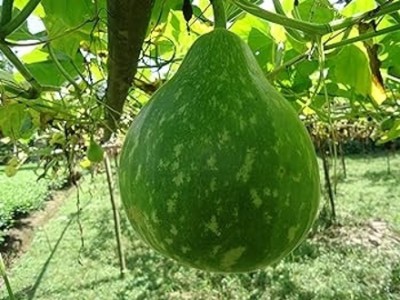BSARKAR Round bottle gourd/ round louki seed Seed(20 per packet)
Quick Overview
Product Price Comparison
The round bottle gourd, scientifically known as Lagenaria siceraria, is a vine plant belonging to the Cucurbitaceae family, cultivated for its edible fruit and versatile uses. Here are detailed descriptions of the round bottle gourd:1. **Fruit Shape and Size**: - **Shape**: As the name suggests, the round bottle gourd typically has a rounded or globular shape. It can also be slightly elongated but generally resembles a large, rounded bottle. - **Size**: The size of the fruit can vary widely depending on the variety and growing conditions, but it generally ranges from small to medium-sized, with some cultivars producing larger fruits.2. **Outer Appearance**: - **Skin**: The fruit has a smooth, hard outer skin that is usually light green when immature and turns pale yellow or white as it matures. The skin can have some variations in texture and color. - **Surface**: The surface of the fruit is typically smooth, with occasional light ribbing or markings.3. **Interior Characteristics**: - **Flesh**: Inside, the round bottle gourd has a crisp, white flesh with a spongy texture. The flesh is mild-tasting and contains numerous seeds embedded in a fibrous matrix. - **Seeds**: The seeds are flat, oval-shaped, and can vary in color from white to brownish-black, depending on the variety.4. **Plant Characteristics**: - **Vine**: The round bottle gourd is a vigorous climbing vine with large, heart-shaped leaves that provide ample shade for the developing fruits. - **Flowers**: The plant produces large, trumpet-shaped flowers that are typically white or yellow and are pollinated by insects.5. **Cultural Uses**: - **Edible Uses**: The flesh of the round bottle gourd is edible and commonly used in various cuisines around the world. It can be cooked in stews, soups, curries, or stir-fries, or eaten raw in salads. - **Utensil and Container**: Historically, the mature, dried fruits of the bottle gourd have been used as natural containers or utensils (hence the name "bottle gourd") for storing water, grains, or other items. - **Medicinal Purposes**: In some traditional medicinal practices, extracts from the fruit and seeds of the bottle gourd are used for their purported health benefits.6. **Cultivation**: - **Growing Conditions**: Bottle gourds prefer warm climates with plenty of sunlight and well-drained soil. They are sensitive to frost and require a long growing season. - **Propagation**: They are typically grown from seeds directly sown into the ground or started indoors and transplanted once the weather warms up. - **Care**: Regular watering and fertilization are essential to promote healthy vine growth and fruit development. Trellising or support structures may be used to keep the vines off the ground and maximize space.7. **Varieties**: - There are several varieties of round bottle gourd, each with specific characteristics such as size, shape, and flavor. Some popular varieties include 'Calabash', 'Dudhi', and 'Long Melon'.Overall, the round bottle gourd is valued not only for its culinary uses but also for its cultural significance and historical roles as a versatile plant with both practical and edible applications.


